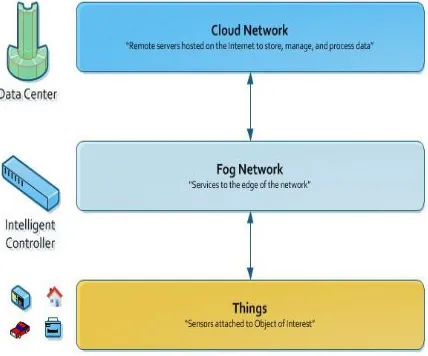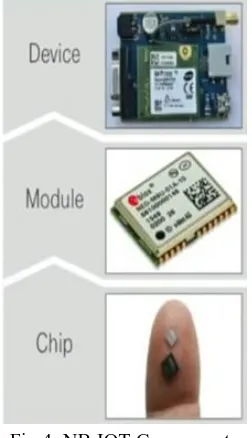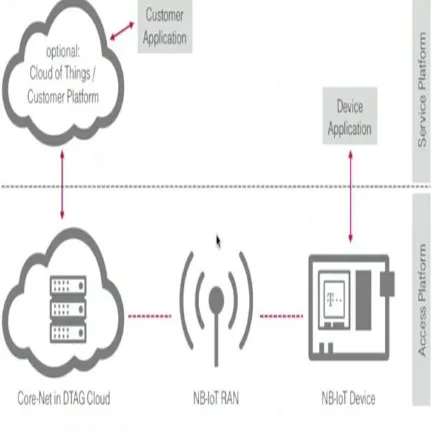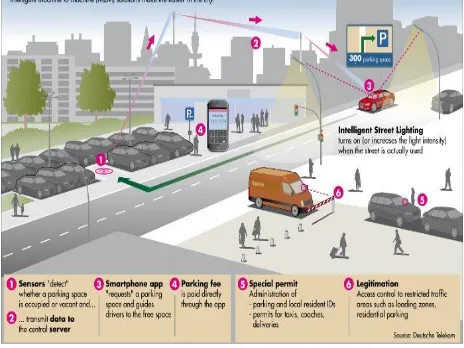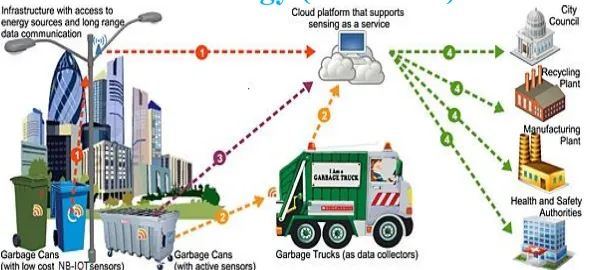Technology (IJRASET)
©IJRASET: All Rights are Reserved
1907
A Survey on Fog Computing and NB-IOT
Ranjiitha K1, Rekha B2
1,2Sem M. Tech Student, Associate Professor Dept. of ISE SJBIT VTU
Abstract: The mobile network standard after Fourth Generation (4G) is Fifth Generation (5G) which is expected to provide internet connections at least 40 times faster than fourth generation. We can consider an example where user can download 600 MB/Sec or even higher on fifth generation rather than downloading 15MB/Sec on fourth generation. Fourth generation wireless broadband is spreading throughout but still we need fifth generation because of its advantages. Till fifth generation of network each generation is the improvisation of previous generation of network. Each generation has its own advantages and disadvantages. To overcome the disadvantages of fourth generation of network the fifth generation came up with advantages to gather all networks on one platform. It provides uniform, uninterruptable and consistent connectivity across the world. This extension of fourth generation with higher data rates better supports Internet of things. Massive connection, ultra-reliable and low latency are limitations of fourth generation network. These limitations are taken as challenges by fifth generation network and can provide many services like smart retail, smart parking and smart waste management based on fog and NB-IOT (Narrow Band-IOT) as discussed further. These services have good solutions provided by technologies like fog computing and NB-IOT.
Keywords: Cloud computing, Fog computing, NB-IOT (Narrow Band-IOT).
I. INTRODUCTION
Fog is a thick cloud of tiny water droplets suspended in the atmosphere near the earth's surface which restricts visibility. Fog in computer science is defined as an architecture that extends services offered by cloud to edge devices. Technically fog is suspended in the Internet of things near the cloud surface and the edge devices. Cloud is a visible mass of condensed watery vapor floating in the atmosphere high above the general level of the ground. In the same way cloud in computer science is a service provider which provides services like platform, storage and other resources through Internet and it is high above from the level of edge devices. Cloud allows to access resources from anywhere and anytime.
II.RELATED WORK
At present human beings are very much dependent on Internet for everything. We expect everything to be fast and secure because of fast moving nature of the generation. So the resources and services of computation, communication, control and storage closer to user is distributed by Fog which contributes an overview of research opportunities [1]. To Increase the privacy and security than the public cloud server Fog node is operated in distributed environment [2]. production as well as in reducing the extra man power efforts the technological development in RAN (Radio Access Network) made it possible for edge caching [3].The way we work, commute, shop & play is transforming to the digital innovation, from Internet of Things (IOT), Artificial Intelligence, Virtual reality, Tactile Internet and 5G applications [4]. How garbage management can be made smart using fog and NB-IOT technologies for smart cities [5]. Fog computing also plays an important role in Internet of things [6].Privacy and security are special attributes of Fog computing. The facility of the new dispense or distributed computing allows request to run as close as possible to sensed, serviceable and huge data, coming out of mankind operation and object. The fog node operated in such a scenario can provide better privacy and security compared to cloud server.
III. CLOUD COMPUTING
Technology (IJRASET)
©IJRASET: All Rights are Reserved
1908
computing design in which the devices are directly connected to the data centric cloud, without any edge devices.
Fig 1: Cloud Computing Model
IV. FOG COMPUTING
[image:3.612.231.373.131.229.2]Fog computing allow us to carry out storage, communication and application services on a distributed manner. Fog computing can also be called as cloud computing closer to edge devices. The fog computing concept was first introduced in present wave of Internet movement with Internet of Thing (IOT). Fig 2 describes the fog computing model. In this model we have fog network in middle it acts as an intermediate layer which brings IOT to life by delivering distributed edge computing.
Fig 2: Fog Computing Model
[image:3.612.199.413.351.529.2]Technology (IJRASET)
©IJRASET: All Rights are Reserved
1909
[image:4.612.205.406.147.262.2]processes and thing. The fog node operated in such an environment can offer better privacy and security than the public cloud server. To provide uniform execution environment for a variety of applications NB-IOT small cell with computing elements is integrated with fog node system software architecture. There are several NB-IOT industry applications such as smart retail, smart home surveillance, smart parking and smart heat management that run on the fog node system architecture.
Fig 3: Fog Computing Architecture
V.NARROW BAND-IOT
NB-IOT (Narrow Band-IOT) is defined as a signal over narrow range of frequencies to connect IOT devices. It can be defined as a narrow band radio technology designed for internet of things that has been developed to enable a wide range of devices and services to be connected using cellular telecommunications bands. It is also called as a network designed for “simple” things. NB-IOT focuses on low cost, long battery life and enabling large number of connected devices. The main advantages of NB-NB-IOT are Security, Public Network, Support of huge existing ecosystem, Scalable and Deployable. Fig 4 shows some of the basic components of NB-IOT they are Device, Module, and Chip.
Fig 4: NB-IOT Components
[image:4.612.244.370.397.616.2]Technology (IJRASET)
©IJRASET: All Rights are Reserved
1910
main aspect of the Fog node in this NB-IOT application system is elucidated as diffused or Virtual server incorporated from cloud center and its geo-location is near or close to the mobile devices, sensor networks, or IOT devices.
VI. BASIC SETUP OF NB-IOT
[image:5.612.198.415.208.425.2]Fig 5 represents the basic setup of NB-IOT, from this figure we can observe that both device and application in different platform interact with each other. The basic setup of NB-IOT include NB-IOT device, NB-IOT RAN (Radio Access Network), cloud, customer application and device application. The NB-IOT device is connected by a radio access network to the cloud. In access layer the devices access the cloud through fog and in service platform service is provided as application to user. This basic setup can lead to many applications of fog node with NB-IOT consortium.
Fig 5: Basic setup of NB-IOT
VII. APPLICATIONS OF FOG NODE WITH NB-IOT CONSORTIUM
There are many industry applications on fog node software system. They may include (i) Utilities - Services consumed by public like Electricity, Gas, and Water. (ii) Transport and Logistics - Effective transportation and storage of goods like goods tracking. (iii) Consumer Electronics - Electronic or digital equipment intended for everyday use like wearable, consumables replenishment for appliances typically in home. (iv) Public sector - The part of an economy that is controlled by state like smart street lighting, smart parking, and smart waste management. (v) Smart Buildings – Purpose of using automated action to automatically control the activities in the building like lighting system, alarm systems, access controls and other systems Design. (vi) Industrial Automation - Use of control systems, such as computers, robots or information technologies for handling different processes and machineries like vending machines and industrial equipment management in an industry to replace a human being. Out of all this applications we will now discuss three smart services that can be implemented on the Fog node for NB-IOT applications they are smart retail, smart parking and smart waste management.
A.Smart Retail application based on Fog and NB-IOT
Technology (IJRASET)
[image:6.612.150.465.85.246.2]©IJRASET: All Rights are Reserved
1911
Fig 6: Smart Retail based on NB-IOT
B.Smart parking application based on Fog and NB-IOT
Using smart parking application based on Fog and NB-IOT, parking can be smarter than ever. Fig 7 illustrates the operation procedures of smart parking using Fog and NB-IOT. In this proposed system each parking slot is assigned with a NB-IOT sensor with unique parking ID. But to access these proposed system the main criteria is that each vehicle has to equip a NB-IOT sensor issued by the parking service providers. The NB-IOT small cells and FOG nodes can be deployed by the IOT communication providers. Operation of the smart parking system is in the following way. At first the NB-IOT small cell sensors are integrated on the parking slots and the vehicles, then during the time of parking the vehicle, the NB-IOT sensors detect whether a parking space is occupied or vacant and transmit data to the central server. Then smartphone app “requests” a parking space and guides drivers to the free space. The parking fee is paid directly through the app. The deployment of Smart parking NB-IOT sensors and fog node is expected to take place with the further development of 5th generation Technologies.
Fig 7: Smart parking based on Fog and NB-IOT.
C.Smart waste management based on Fog and NB-IOT
[image:6.612.190.422.412.586.2]Technology (IJRASET)
[image:7.612.159.456.76.211.2]©IJRASET: All Rights are Reserved
1912
Fig 8: Smart waste management based on NB-IOT.
VIII.sCONCLUSION
In this survey it is described how the technology development from Fourth Generation network to the Fifth Generation have challenges like low latency, massive connections, and ultra- reliability that can overcome from fog computing and NB-IOT technology. In this point of view the technologies like cloud computing, Fog computing and the NB-IOT technology are discussed. There are many applications of NB-IOT cells integrated with fog computing technology. As of now we have the three applications like smart retail smart parking and smart waste management based on fog and NB-IOT are discussed. All the three applications are those which give solutions to the major problems faced by the public. So these cutting edge applications are the one which overcome the challenges of fifth generation by fog computing and NB-IOT technology.
REFERENCES
[1] M. Chiang and T. Zhang, "Fog and IOT: An Overview of Research Opportunities," IEEE Internet of Things Journal, 2016
[2] I. Stojmenovic and S. Wen, "The Fog Computing Paradigm: Scenarios and Security Issues", Computer Science and Information Systems, 2014 [3] M. Peng, S. Yan, K.Zhang, and C. Wang, "Fog Computing based Radio Access Networks: Issues and Challenges," IEEE Networks, vol. 30, no. 4, 2016 [4] Open Fog Reference Architecture for Fog Computing, Produced by the Open Fog Consortium Architecture Working Group, Feb 2017
[5] Mohammad Azam, Marc St-Hilaire and Chung-Horng Lung, “Cloud based smart waste management for smart cities” IEEE International workshop, Oct 2016 [6] (2017) Emerging challenges and fig 2:Cloud computing model from Future is in fog computing. Available:https://volansys.com/future-is-fog-computing/ [7] (2017)The wikipedia website[online]. Available:https://www.wikipedia.org/
